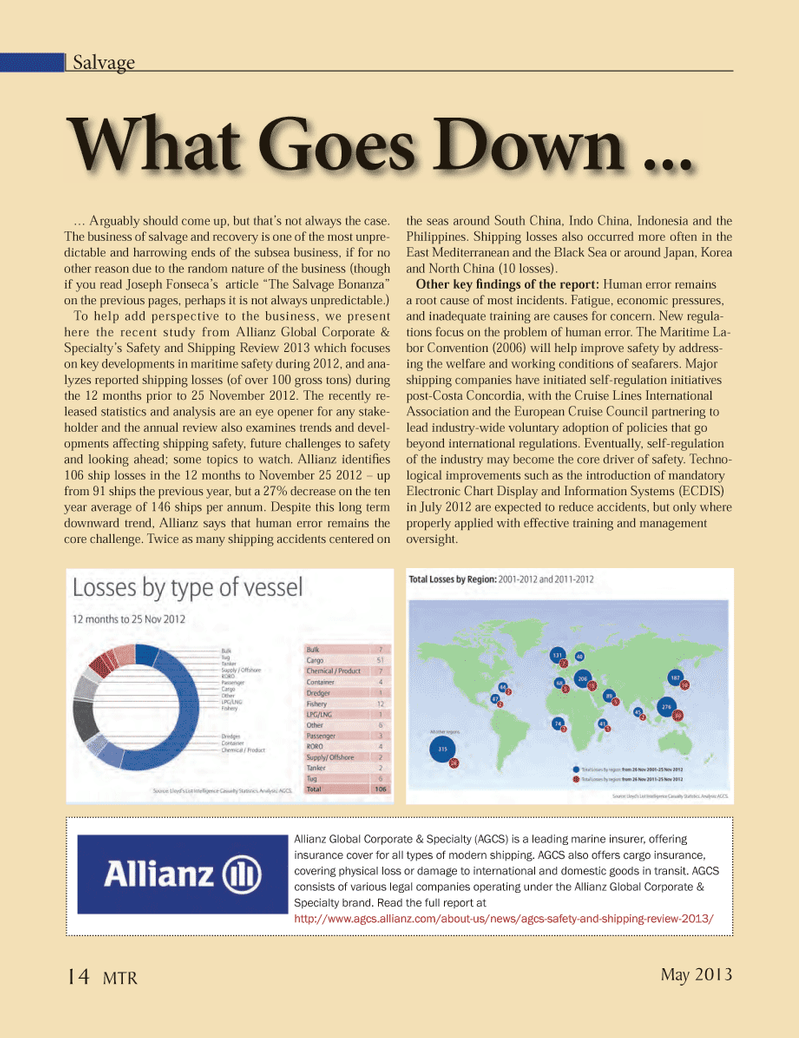
Page 14: of Marine Technology Magazine (May 2013)
Hydrographic Survey
Read this page in Pdf, Flash or Html5 edition of May 2013 Marine Technology Magazine
Salvage ... Arguably should come up, but that?s not always the case. The business of salvage and recovery is one of the most unpre- dictable and harrowing ends of the subsea business, if for no other reason due to the random nature of the business (though if you read Joseph Fonseca?s article ?The Salvage Bonanza? on the previous pages, perhaps it is not always unpredictable.) To help add perspective to the business, we present here the recent study from A llianz Global Corporate & Specialty?s Safety and Shipping Review 2013 which focuses on key developments in maritime safety during 2012, and ana- lyzes reported shipping losses (of over 100 gross tons) during the 12 months prior to 25 November 2012. The recently re- leased statistics and analysis are an eye opener for any stake- holder and the annual review also examines trends and devel- opments affecting shipping safety, future challenges to safety and looking ahead; some topics to watch. Allianz identi es 106 ship losses in the 12 months to November 25 2012 ? up from 91 ships the previous year, but a 27% decrease on the ten year average of 146 ships per annum. Despite this long term downward trend, Allianz says that human error remains the core challenge. Twice as many shipping accidents centered on the seas around South China, Indo China, Indonesia and the Philippines. Shipping losses also occurred more often in the East Mediterranean and the Black Sea or around Japan, Korea and North China (10 losses).Other key Þ ndings of the report: Human error remains a root cause of most incidents. Fatigue, economic pressures, and inadequate training are causes for concern. New regula- tions focus on the problem of human error. The Maritime La- bor Convention (2006) will help improve safety by address- ing the welfare and working conditions of seafarers. Major shipping companies have initiated self-regulation initiatives post-Costa Concordia, with the Cruise Lines International Association and the European Cruise Council partnering to lead industry-wide voluntary adoption of policies that go beyond international regulations. Eventually, self-regulation of the industry may become the core driver of safety. Techno- logical improvements such as the introduction of mandatory Electronic Chart Display and Information Systems (ECDIS) in July 2012 are expected to reduce accidents, but only where properly applied with effective training and management oversight. What Goes Down ... Allianz Global Corporate & Specialty (AGCS) is a leading marine insurer, offering insurance cover for all types of modern shipping. AGCS also offers cargo insurance, covering physical loss or damage to international and domestic goods in transit. AGCS consists of various legal companies operating under the Allianz Global Corporate & Specialty brand. Read the full report at http://www.agcs.allianz.com/about-us/news/agcs-safety-and-shipping-review-2013/ May 201314 MTRMTR #4 (1-17).indd 14MTR #4 (1-17).indd 145/6/2013 9:56:44 AM5/6/2013 9:56:44 AM

 13
13

 15
15
